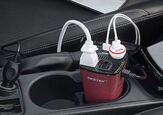The ES90 Will Be Volvo's First 800-Volt EV

The Volvo ES90 will arrive soon as an upscale electric sedan with impressive range numbers and advanced driver-assistance tech, but the big story with the new car has to do with its electrical architecture. Volvo said the ES90 will land as its first vehicle with 800-volt architecture, allowing super-fast charging.
The car promises 435 miles of range on the WLTP test cycle, but it’s good to remember that the EPA’s estimates are generally much more conservative. Even so, getting anywhere close to 400 miles on a charge would make the ES90 one of the longest-range EVs on sale.
Most new EVs feature a 400-volt electric architecture, but the 800-volt system promised by Volvo will enable the ES90 to charge from 10 to 80 percent in 20 minutes. The technology is slowly creeping into the market, with new EVs from Hyundai, Kia, Porsche, and others opting for 800-volt over 400-volt architectures.
Advantages of an 800-volt system include the ability to charge faster without needing heavier cables. It is also more efficient than 400-volt architectures, reducing heat loss during charging.
The ES90 will also feature the sensor array and other tech that enable advanced driver-assistance features, including hands-free driving. That said, we don’t know much about the car otherwise, including its battery size or pricing. Volvo will release more specs, including EPA range estimates, closer to the car’s launch.
[Images: Volvo]
Become a TTAC insider. Get the latest news, features, TTAC takes, and everything else that gets to the truth about cars first by subscribing to our newsletter.

Chris grew up in, under, and around cars, but took the long way around to becoming an automotive writer. After a career in technology consulting and a trip through business school, Chris began writing about the automotive industry as a way to reconnect with his passion and get behind the wheel of a new car every week. He focuses on taking complex industry stories and making them digestible by any reader. Just don’t expect him to stay away from high-mileage Porsches.
More by Chris Teague
Latest Car Reviews
Read moreLatest Product Reviews
Read moreRecent Comments
- MaintenanceCosts The Truth About Isuzu Troopers!
- Jalop1991 MC's silence in this thread is absolutely deafening.
- MaintenanceCosts Spent some time last summer with a slightly older Expedition Max with about 100k miles on the clock, borrowed from a friend for a Colorado mountain trip.It worked pretty well on the trip we used it for. The EcoBoost in this fairly high state of tune has a freight train feeling and just keeps pulling even way up at 12k ft. There is unending space inside; at one point we had six adults, two children, and several people's worth of luggage inside, with room left over. It was comfortable to ride in and well-equipped.But it is huge. My wife refused to drive it because she couldn't get comfortable with the size. I used to be a professional bus driver and it reminded me quite a bit of driving a bus. It was longer than quite a few parking spots. Fortunately, the trip didn't involve anything more urban than Denver suburbs, so the size didn't cause any real problems, but it reminded me that I don't really want such a behemoth as a daily driver.
- Jalop1991 It seems to me this opens GM to start substituting parts and making changes without telling anyone, AND without breaking any agreements with Allison. Or does no one remember Ignitionswitchgate?At the core of the problem is a part in the vehicle's ignition switch that is 1.6 millimeters less "springy" than it should be. Because this part produces weaker tension, ignition keys in the cars may turn off the engine if shaken just the right way...2001: GM detects the defect during pre-production testing of the Saturn Ion.2003: A service technician closes an inquiry into a stalling Saturn Ion after changing the key ring and noticing the problem was fixed.2004: GM recognizes the defect again as the Chevrolet Cobalt replaces the Cavalier.fast forward through the denials, driver deaths, and government bailouts2012: GM identifies four crashes and four corresponding fatalities (all involving 2004 Saturn Ions) along with six other injuries from four other crashes attributable to the defect.Sept. 4, 2012: GM reports August 2012 sales were up 10 percent from the previous year, with Chevrolet passenger car sales up 25 percent.June 2013: A deposition by a Cobalt program engineer says the company made a "business decision not to fix this problem," raising questions of whether GM consciously decided to launch the Cobalt despite knowing of a defect.Dec. 9, 2013: Treasury Secretary Jacob Lew announces the government had sold the last of what was previously a 60 percent stake in GM, ending the bailout. The bailout had cost taxpayers $10 billion on a $49.5 billion investment.End of 2013: GM determines that the faulty ignition switch is to blame for at least 31 crashes and 13 deaths.It took over 10 years for GM to admit fault.And all because an engineer decided to trim a pin by tenths of a millimeter, without testing and without getting anyone else's approval.Fast forward to 2026, and the Allison name is no longer affiliated with the transmissions. You do the math.
- Normie I'd hate to have to actually use that awkwardly mounted spare tire in a roadside fix scenario. Bumper jack? Tote around a 50 lb. floor jack? That's a high ridin' buggy!




































Comments
Join the conversation
I think EV charging stations will need to be supervised by operators in the way gas stations are today.
We have too many animals and reprobates living among us who are prone to vandalism, theft, hacking and other forms of anti-social behavior for the existing self-service, unsupervised model to work.
..that, as usual, NOBODY WLL BUY
China seems to have some pretty nice automakers, and out of all those, we in the U.S.A. get Volvo? 😅